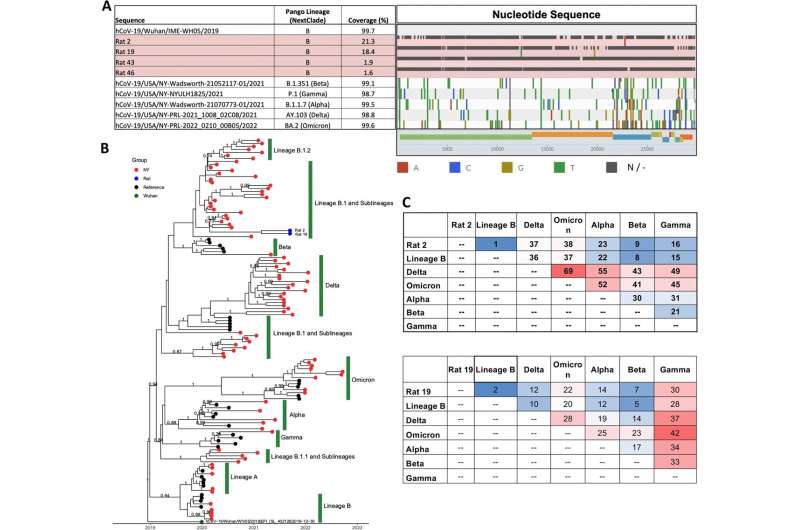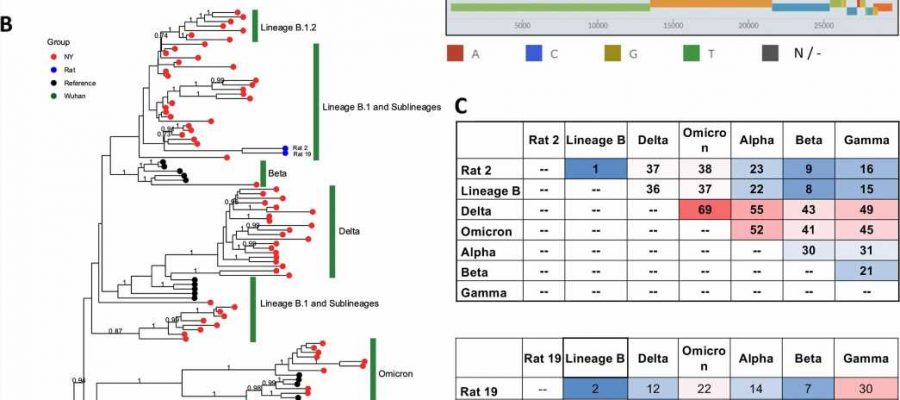
A new study has demonstrated that rats are susceptible to infection with Alpha, Delta and Omicron variants of SARS-CoV-2 and wild rats in the New York City municipal sewer systems and elsewhere in the city have been exposed to SARS-CoV-2. The study was published in mBio.
“Our findings highlight the need for further monitoring of SARS-CoV-2 in rat populations for potential secondary zoonotic transmission to humans,” said study principal investigator Henry Wan, Ph.D., Professor and Director of the Center for Influenza and Emerging Infectious Diseases at the University of Missouri. “Overall, our work in this space shows that animals can play a role in pandemics that impact humans, and it’s important that we continue to increase our understanding so we can protect both human and animal health.”
Rats are widely distributed in urban communities in the United States. For example, New York City alone has approximately eight million wild rats. These wild rats have ample opportunities to interact with humans. Two previous studies suggested that rats in Asia (Hong Kong) and Europe (Belgium) were exposed to SARS-CoV-2; however, it is unknown which SARS-CoV-2 variant these rats were exposed to in both studies.
In the new study, the researchers set out to determine whether the SARS-CoV-2 virus in humans has been transmitted to the rat population in urban areas of the United States, specifically New York City, and if so, which SARS-CoV-2 variant caused those infections. The researchers also set out to determine whether (and which) SARS-CoV-2 variants in NYC can cause infections in rats.
“In Fall of 2021, U.S. Department of Agriculture (USDA) Animal and Plant Health Inspection Service (APHIS) sampled Norway rats (Rattus norvegicus) in New York City to look for evidence of SARS-CoV-2 infection,” said study co-author Tom DeLiberto, D.V.M., Ph.D., SARS-CoV-2 Coordinator at USDA APHIS Wildlife Services.
“Two trapping efforts were conducted during September and November with permission from the NYC Department of Parks and Recreation in and around locations surrounding wastewater systems. Most of the rats were trapped in city parks within Brooklyn, although some were captured near buildings outside of park boundaries.”
Biologists collected and processed samples from 79 rats for virological studies and genomic sequencing. The researchers found that the rats were exposed to SARS-CoV-2 and showed a possible link to the viruses that were circulating in humans during the early stages of the COVID-19 pandemic. Specifically, 13 of 79 rats (16.5%) tested positive. “To the best of our knowledge, this is one of the first studies to show SARS-CoV-2 variants can cause infections in the wild rat populations in a major U.S. urban area,” Dr. Wan said.
To further investigate rat susceptibility to SARS-CoV-2 variants, the researchers conducted a virus challenge study and showed that Alpha, Delta and Omicron variants (variants found in humans) can cause infections in rats (wild-type Sprague Dawley rats), including high replication levels in the upper and lower respiratory tracts and induction of both innate and adaptive immune responses. Susceptibility to infection varied by type of variant.
“Our findings highlight the need for further monitoring of SARS-CoV-2 in rat populations to determine if the virus is circulating in the animals and evolving into new strains that could pose a risk to humans,” Dr. Wan said. “SARS-CoV-2 virus presents a typical one-health challenge which requires collaborative, multisectoral and transdisciplinary approaches to fully understand such challenges.”
More information:
Yang Wang et al, SARS-CoV-2 Exposure in Norway Rats (Rattus norvegicus) from New York City, mBio (2023). DOI: 10.1128/mbio.03621-22
Journal information:
mBio
Source: Read Full Article
